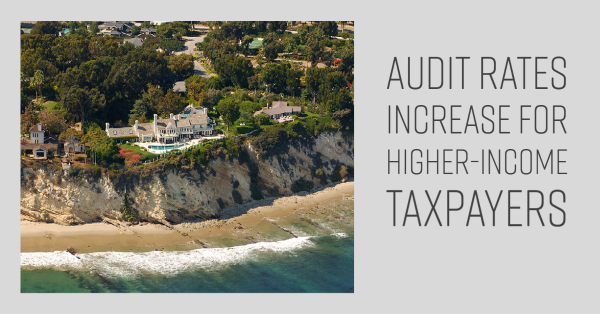Audit Rates Increase for Higher-Income Taxpayers

Despite common misperceptions about IRS examination rates, the reality is that the likelihood of an audit significantly increases as income grows. Read the full report by the IRS Deputy Commissioner for Services and Enforcement, Sunita Lough.
Taxpayers with incomes of $10 million and above had substantially higher audit rates than taxpayers in every other income category for each calendar year from 2010 through 2015. Those with incomes above $1 million also had higher exam rates than all other groups earning less.
Tax Year 2015 provides a good historical overview of where IRS compliance priorities are focused. The exam coverage rate of taxpayers with incomes of $10 million or more is 8.16%. The rate for those between $1 million and $10 million is 2.53%. And other income categories are far below that – generally less than 1%.
Tax Year 2015 is the last year for which we know the actual audit rates, because the IRS can still open audits for more recent years, so the data for more recent years is not yet complete.>
Note: The IRS normally has three years to assess tax from when a return was filed. For example, the IRS would normally have until at least October 15, 2021 to assess additional tax on a tax return filed October 15, 2018, for the 2017 tax year.
Higher-income tax returns are more complex, and they can take much more time to complete – frequently several years after the tax return is filed. Therefore, to get the complete picture of the audit rate for a specific tax year, audits in process as well as completed audits must be included.
On the other hand, audits of low- and moderate-income tax returns take less time to resolve. Each year, approximately 25 million lower-income taxpayers seek a refundable EITC which on their return involves a single issue that can be quickly resolved, sometimes within a month or so of filing the return. The IRS prioritizes a prompt review of these returns in order to quickly issue the EITC refund to people in need, most frequently within 21 days following the filing of the return, without any further audit of such returns. The average time to complete an EITC audit is five hours per return.
The IRS averages approximately 300,000 EITC audits per year out of the universe of 25 million. The total universe of tax year 2015 returns in income categories of $1 to $5 million, $5 million to $10 million and $10 million and over was 478,772. It is important to look at the percentage of filers audited in each income category rather than merely the number of audits in each income category.
The chart below shows that higher-income taxpayers were audited at much higher rates in 2013-2015. Data is not yet complete for the more recent years, particularly for high-income taxpayers for the 2016 through 2018 tax years, where many examinations are in the process or have yet to even begin.
IRS Audit Rates by Income Category: 2013-2015 shows more exams for higher income over time
| Total positive income | Total returns filed in TY2013 | Returns examined* | Percent covered |
|---|---|---|---|
| No total positive income** | 619,694 | 78,573 | 12.68 |
| $1 under $25,000 | 56,181,555 | 464,856 | 0.83 |
| $25,000 under $50,000 | 34,753,396 | 121,841 | 0.35 |
| $50,000 under $75,000 | 19,532,032 | 63,700 | 0.33 |
| $75,000 under $100,000 | 12,787,903 | 52,852 | 0.41 |
| $100,000 under $200,000 | 17,451,788 | 90,236 | 0.52 |
| $200,000 under $500,000 | 4,844,782 | 40,290 | 0.83 |
| $500,000 under $1,000,000 | 800,121 | 11,802 | 1.48 |
| $1,000,000 under $5,000,000 | 342,605 | 10,782 | 3.15 |
| $5,000,000 under $10,000,000 | 23,413 | 1,499 | 6.40 |
| $10,000,000 and above | 14,009 | 1,689 | 12.06 |
| Total positive income | Total returns filed in TY2014 | Returns examined* | Percent covered |
|---|---|---|---|
| No total positive income** | 662,876 | 49,829 | 7.52 |
| $1 under $25,000 | 54,956,300 | 390,799 | 0.71 |
| $25,000 under $50,000 | 35,090,262 | 147,805 | 0.42 |
| $50,000 under $75,000 | 19,676,659 | 82,822 | 0.42 |
| $75,000 under $100,000 | 13,130,657 | 49,717 | 0.38 |
| $100,000 under $200,000 | 18,405,264 | 73,729 | 0.40 |
| $200,000 under $500,000 | 5,324,980 | 29,884 | 0.56 |
| $500,000 under $1,000,000 | 910,977 | 10,362 | 1.14 |
| $1,000,000 under $5,000,000 | 401,634 | 10,651 | 2.65 |
| $5,000,000 under $10,000,000 | 28,847 | 1,512 | 5.24 |
| $10,000,000 and above | 18,122 | 1,572 | 8.67 |
| Total positive income | Total returns filed in TY2015 | Returns examined* | Percent covered |
|---|---|---|---|
| No total positive income** | 701,594 | 31,329 | 4.47 |
| $1 under $25,000 | 54,135,898 | 357,410 | 0.66 |
| $25,000 under $50,000 | 35,589,401 | 141,727 | 0.40 |
| $50,000 under $75,000 | 20,312,858 | 108,219 | 0.53 |
| $75,000 under $100,000 | 13,063,770 | 64,324 | 0.49 |
| $100,000 under $200,000 | 19,459,846 | 92,124 | 0.47 |
| $200,000 under $500,000 | 5,788,644 | 31,804 | 0.55 |
| $500,000 under $1,000,000 | 962,481 | 10,898 | 1.13 |
| $1,000,000 under $5,000,000 | 428,082 | 10,244 | 2.39 |
| $5,000,000 under $10,000,000 | 31,159 | 1,367 | 4.39 |
| $10,000,000 and above | 19,531 | 1,593 | 8.16 |
Source: Table 17a, Internal Revenue Data Book, 2019
*Returns examined is total of columns “Closed” and “in process”.
** Returns that show no total positive income report zero or negative income. The negative income could be negative business income and/or capital losses. Returns with no TPI are filed by taxpayers in any of the income categories, and there is no prevalence of one over the other. These returns account for less than 0.5% of the individual filing population.
The typical audits for higher-income taxpayers involve at least three different tax years, often include related entities, and routinely take years to resolve. The highest income taxpayers face the most significant chance of an examination, and they face the most highly trained and experienced IRS agents and teams utilizing our most sophisticated tools and techniques.
At the end of the day, the IRS strives to properly serve compliant taxpayers and uphold the nation’s tax laws, ranging from civil side audits and notices to criminal investigations in the most egregious cases. We face tough choices each year as far as where to deploy resources given the breadth of our responsibilities, but our choices are guided by fair and impartial audit plans throughout the process.
Sunita Lough
IRS Deputy Commissioner for Services and Enforcement




